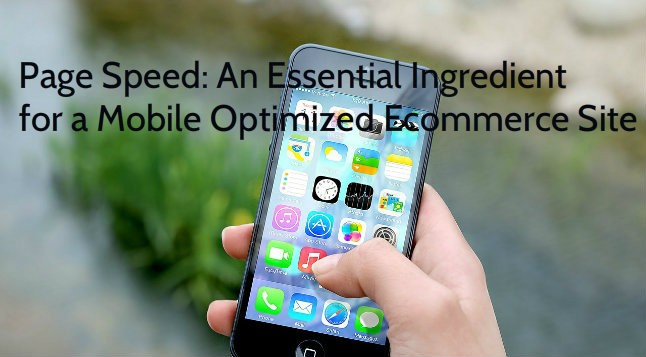
Page Speed: An Essential Ingredient for a Mobile Optimized Ecommerce Site
When you think about it, the dramatic rise in mobile web traffic doesn’t come as much of a surprise. Desktop and laptop computers can only be used when you’re in a suitable environment which is usually a room with a desk and chair. In contrast, mobile devices are on your person wherever you go. Almost everywhere is a suitable environment for their use. Unless you have a need for a large viewing screen, it doesn’t make sense to not take advantage of the convenient Internet access made possible by mobile devices.
This increase in mobile traffic is the reason websites and ecommerce sites in particular, must be mobile friendly. Failure to accommodate mobile traffic means losing ever-increasing numbers of sales to other sites that are suitably optimized. However, many ecommerce site owners don’t have a complete understanding of what makes a site mobile friendly. They often install a plug-in software module to their site that resizes it to match the screen size of the viewing mobile device. This by itself is inadequate because a scaled down desktop website does not satisfy the usability requirements of the mobile user.
Small buttons and pull down menus that work well on large desktop screens are too small for people with tiny mobile screens. Complicated graphics full of subtle coloring also make for difficult viewing when seen under the varying light conditions of the many environments where mobile devices are used. Usability also requires that you keep text inputs to a minimum and to make links and buttons large with plenty of contrast.
Mobile optimization really comes down to one thing: creating a great user experience. Few but the most determined of visitors will stick around on an ecommerce site that causes frustration. In addition to accommodating the mobile visitor’s reduced screen size with its special usability requirements, your site must load rapidly. Speed is equally important as usability. Here are two important reasons for this:
People Are Naturally Impatient and Mobile Users Are Even More So
The desktop user sets aside time for browsing the Internet and can give the task his full attention. He has more time and a bit more inclination to wait for your ecommerce site to load. In contrast, the mobile user is probably multitasking while viewing your site. He has a limited time window to find and purchase an item he requires before attending a meeting or getting off an elevator. Finding what he needs will require viewing several pages which means he can’t wait around if every one of them loads slowly.
Mobile Network Internet Access Is Slower than High Speed Cable Access
Mobile networks have a lot of built-in latency. Latency is the round trip time delay associated with accessing the Internet and then receiving data from your website in the mobile device’s browser. It takes time for data to travel from a mobile device through the cell tower, and then through a radio network controller, and then through the core network which then accesses the public Internet. There is further delay when data from your website makes the return trip back through the same interfaces to the mobile device.
By the time the mobile user reaches your site, his patience is already a bit strained. In addition to the network latency problem, mobile devices have less processing power than desktop computers. This means they take longer to render web pages. This is why your ecommerce site must not add any more significant delay. It must be optimized for speed. You can start doing this by getting your site tested at GTmetrix. GTmetrix will rate your site and point out deficiencies that you can then act on.
If your ecommerce site is hosted on a slow server however, no amount of optimization will eliminate the server’s time delay. There are a variety of reasons for slow web servers. One common reason is using shared web hosting with a company that overloads their shared servers with too many websites. When one or more websites use too much bandwidth, every website on the shared server suffer from slow loading times.
Another reason is a server that lacks the capacity to handle your site’s bandwidth requirements. If you suspect that a slow server is causing your site to load slowly or inconsistently, contact us at Applied Innovations. We have reliable hosting that provides both continuous uptime and high server speed.
Photo Source / Desaturated from original
